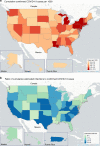Substantial underestimation of SARS-CoV-2 infection in the United States
- PMID: 32908126
- PMCID: PMC7481226
- DOI: 10.1038/s41467-020-18272-4
Substantial underestimation of SARS-CoV-2 infection in the United States
Abstract
Accurate estimates of the burden of SARS-CoV-2 infection are critical to informing pandemic response. Confirmed COVID-19 case counts in the U.S. do not capture the total burden of the pandemic because testing has been primarily restricted to individuals with moderate to severe symptoms due to limited test availability. Here, we use a semi-Bayesian probabilistic bias analysis to account for incomplete testing and imperfect diagnostic accuracy. We estimate 6,454,951 cumulative infections compared to 721,245 confirmed cases (1.9% vs. 0.2% of the population) in the United States as of April 18, 2020. Accounting for uncertainty, the number of infections during this period was 3 to 20 times higher than the number of confirmed cases. 86% (simulation interval: 64-99%) of this difference is due to incomplete testing, while 14% (0.3-36%) is due to imperfect test accuracy. The approach can readily be applied in future studies in other locations or at finer spatial scale to correct for biased testing and imperfect diagnostic accuracy to provide a more realistic assessment of COVID-19 burden.
Conflict of interest statement
The authors declare no competing interests.
Figures



References
Publication types
MeSH terms
LinkOut - more resources
Full Text Sources
Miscellaneous

